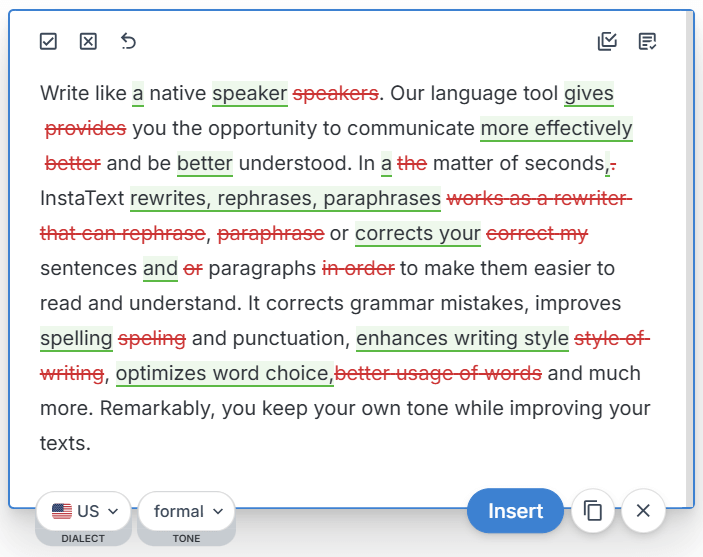Have you used AI or AI-assisted tools to improve your academic work, and are now wondering how to disclose this as required by the journal to which you are submitting?
This guide defines these technologies, helps you properly declare their use, provides ready-to-use templates, and highlights important issues related to the use of AI in academic writing that can help you maintain academic integrity.
Let’s first take a look at the definitions of AI and AI-assisted tools and the different ways they can be used in academic writing and find out which of them are prohibited in academia and which are not.
AI or AI-assisted tools
When writing academic papers, it is important to distinguish between tools that generate content almost autonomously and those that merely support the author in improving their own writing.
AI technologies
AI technologies are systems that can almost autonomously generate text, images, or other outputs based on user prompts or received data. In this case, human input is limited and the actual work is done by the tool used.
AI-assisted technologies
AI-assisted technologies, on the other hand, act as supportive tools. They do not replace the human author, but help improve aspects such as clarity, accuracy, or presentation.
Understanding this distinction is crucial for proper disclosure. As we discuss in the next section, academic guidelines often treat AI-generated content differently than technologies that support the researcher’s own contributions.

See also: Academic writing myths that are holding you back
Use cases of AI or AI-assisted technologies
AI or AI-assisted AI technologies can provide academics with various levels of support, from content assistance to editing assistance.
Content assistance
AI technologies can be used for content assistance, from literature research to creating outlines and summarising content. As long as this type of support is used to inform the author and guide the research process, with proper human oversight, it is generally considered a legitimate use within academic guidelines.
However, if the output generated by the tool is used as it is, it usually violates the guidelines for originality and authorship of academic journals.
Academic policies on AI-generated content
Most major journals now have clear policies on AI-generated content. Below is an overview of the positions of some major publishers.
“AI does not meet the Cambridge requirements for authorship, given the need for accountability… AI and LLM tools may not be listed as an author on any scholarly work published by Cambridge… Authors are accountable for the accuracy, integrity and originality of their research papers, including for any use of AI.”
“Authors should not list AI and AI-assisted technologies as an author or co-author, nor cite AI as an author. Authorship implies responsibilities and tasks that can only be attributed to and performed by humans… Authors are also responsible for ensuring that the work is original…”
“Large Language Models (LLMs), such as ChatGPT, do not currently satisfy our authorship criteria…”
These publication guidelines reflect those of leading academic institutions such as the Committee on Publication Ethics (COPE), the International Committee of Medical Journal Editors (ICMJE), and the Council of Science Editors (CSE), which declare that AI-generated content does not meet the criteria for originality and authorship.
Researchers must therefore use AI and AI-assisted technologies very prudently for content assistance if they want to avoid jeopardising their reputation and career, maintain academic integrity, meet the criteria of authorship and originality, and increase their chances of successfully publishing their work.
Editing assistance
Another way AI and AI-assisted tools can be used is for editing assistance. There are different levels to this as well. When AI is used for language improvement, enhancing elements such as spelling, grammar, clarity, and word choice, it is typically considered acceptable in academic publishing.
However, if tools using this technology make substantial changes such as extensive rephrasing, rewriting, or redrafting, it falls outside the acceptable limits.
As academic publications point out, regardless of whether such technologies are used for content or editing assistance, the author is ultimately fully responsible for the published work in terms of factors such as the accuracy of data and citations, research integrity, the originality of the work, and compliance with ethical and authorship standards.
Note: AI and AI-assisted translation tools are also widely used to draft or refine manuscripts in another language. Their use is generally acceptable in academic publishing, provided that the author carefully reviews the output. As with other tools, authors remain fully responsible for the final text and should disclose the use of translation tools if required by the journal’s policies.

See also: How InstaText makes translators more productive
Disclosure requirements
At the time of writing this article, all major academic publications require authors to disclose any use of AI or AI-assisted technologies throughout the research and writing process. However, the details of disclosure requirements may vary across journals and disciplines. Some require a declaration only for content assistance, while others require acknowledgement for both content assistance and editing assistance.
These disclosures are necessary to ensure transparency, uphold academic integrity, and make clear the extent to which AI tools have contributed to the work.
As Elsevier puts it, “Declaring the use of these technologies supports transparency and trust between authors, readers, reviewers, editors and contributors and facilitates compliance with the terms of use of the relevant tool or technology.”
Let’s take a look at some disclosure guidelines on content assistance and editing assistance.
“Authors should disclose in their manuscript the use of AI and AI-assisted technologies and a statement will appear in the published work.”
International Committee of Medical Journal Editors (ICMJE)
“At submission, the journal should require authors to disclose whether they used Artificial Intelligence (AI) assisted technologies (such as Large Language Models [LLMs], chatbots, or image creators) in the production of submitted work. Authors who use such technology should describe, in both the cover letter and the submitted work in the appropriate section if applicable, how they used it. For example, if AI was used for writing assistance, describe this in the acknowledgment section… If AI was used for data collection, analysis, or figure generation, authors should describe this use in the methods…”
“Use of an LLM should be properly documented in the Methods section (and if a Methods section is not available, in a suitable alternative part) of the manuscript. The use of an LLM (or other AI-tool) for “AI assisted copy editing” purposes does not need to be declared. In this context, we define the term ‘AI assisted copy editing’ as AI-assisted improvements to human-generated texts for readability and style, and to ensure that the texts are free of errors in grammar, spelling, punctuation and tone. These AI-assisted improvements may include wording and formatting changes to the texts, but do not include generative editorial work and autonomous content creation. In all cases, there must be human accountability for the final version of the text and agreement from the authors that the edits reflect their original work.”
Implications for authors
Authors must be aware that unacknowledged or not fully acknowledged use of AI or AI-assisted technologies breaches disclosure guidelines and could have a negative impact on assessment outcomes.
See also: Can you use generative AI in peer review process?
How to acknowledge use of AI or AI-assisted technologies
Once you understand how journals classify AI use, the next step is knowing how to acknowledge it properly. The first and most important rule is to check the specific guidelines of the journal you are submitting to.
Some publishers provide their own templates or exact wording for disclosure statements. If your target journal offers this guidance, you should always follow it. If this is not the case, you can use the following examples as a starting point and adapt them to your requirements.
Keep in mind that a strong acknowledgement typically includes:
- The name of the tool or tools used
- The purpose of use (e.g. content assistance, editing)
- An explanation of how the tool specifically supported your work
- A statement that you reviewed and edited the output and take full responsibility for the final work
- The version of the tool, the date it was used, and/or the prompts entered (if required by the journal)
Templates for different types of use
When tools are used for content assistance, a disclosure might read:
“During the preparation of this manuscript, the author(s) used [tool name, version if available] for content assistance, specifically to [e.g. create an outline, summarise literature, structure arguments]. The author(s) reviewed and revised the material generated and take(s) full responsibility for the content of this publication.”
When they are used for editing assistance, an appropriate statement could be:
“The author(s) used [tool name, version if available], an AI-assisted editing tool, to improve spelling, grammar, clarity, and readability during manuscript preparation. After using this tool, the author(s) carefully reviewed and edited the text and take(s) full responsibility for the final content.”
For translation assistance, where text is converted from one language into another, you could use a statement such as:
“Parts of this manuscript were translated from [language] into English using [translation tool, version if available]. The author(s) reviewed and revised the translation for accuracy, terminology, and meaning, and take(s) full responsibility for the final text.”

What if no AI was used?
Some journals require a statement regardless of whether you used AI. If this applies to your submission and you have not used any AI or AI-assisted tools, you can simply write:
“I have not used any AI or AI-assisted technologies to prepare this work.”
Using multiple tools
If you used more than one tool, you should declare them all. For example, if you used DeepL for translation and InstaText for editing, both should appear in your acknowledgement. Being transparent about the variety of tools you have used creates clarity for reviewers and ensures that your work cannot be accused of omission or lack of disclosure.
A template for multiple tools might look like this:
“During the preparation of this manuscript, the author(s) used DeepL (version if available) for translation from [language] to English and InstaText (version if available) for editing assistance to improve grammar and readability. The author(s) reviewed and revised all outputs from these tools and take(s) full responsibility for the final content of the work.”
Placement of the acknowledgement
A question many authors have is where exactly to place their declaration. It is often recommended to place it after the reference list and before any appendices, under a heading such as “Declaration” or “Acknowledgement of AI use.”
Do declarations count toward the word limit?
In most cases, declarations are not included in the word count of your manuscript. They are treated in the same way as reference lists, appendices, or acknowledgements – additional material that supports the main text but is not part of it.
However, practices can vary across journals, institutions, and disciplines. Some may explicitly exclude declarations, while others might have different rules depending on the type of submission.
For this reason, it is always wise to check the specific instructions for authors provided by your target journal or the guidance given by your university before finalising your work.

InstaText: How to declare its use
If you have used InstaText when writing your manuscript and are wondering how to declare it, the following information can help you do so properly.
InstaText, as you may know, is an editing assistant that uses advanced language technologies. It is therefore considered an “AI-assisted technology” but does not rely on generative AI.
In other words, unlike tools like ChatGPT, it does not generate content for you. It only improves the text you provide in terms of spelling, grammar, word choice, readability, and clarity.
It does not alter the author’s voice and intent, introduce new information that could change the text beyond recognition or make it inaccurate, or reuse word combinations from other sources that could risk plagiarism.

For this reason, InstaText falls within the category of “editing assistance” and complies with the authorship and originality criteria of academic publications. Authors can therefore use it with confidence, knowing that it supports them in maintaining academic integrity.
Disclaimer: If a user submits text generated by AI that already contains plagiarism, InstaText cannot guarantee the edited copy will be plagiarism-free. If the original text is free of plagiarism, InstaText will not introduce any changes that compromise originality. Users are responsible for making sure their submissions are original. Also, with InstaText, users have full control over the editing process and can accept or reject suggested edits.
Declaration template for InstaText
As discussed, if you are required to disclose the use of AI-assisted technologies, you should include how InstaText was used and confirm that you reviewed the output and take full responsibility for the final text. Here are example templates you can adapt:
Example declaration
During the preparation of this manuscript, the author(s) used InstaText, an AI-assisted editing tool for language improvement, specifically to improve spelling, grammar, word choice, readability, and clarity. After using this tool, the author(s) reviewed and revised the text as needed and take(s) full responsibility for the content of the publication.
Example with multiple tools
During the preparation of this manuscript, the author(s) used DeepL for translation from [language] to English and InstaText for editing assistance and language improvement, specifically to improve spelling, grammar, word choice, readability, and clarity. The author(s) reviewed and revised all outputs from these tools and take(s) full responsibility for the final content of the work.

Achieve academic success with InstaText
If you want your work to read clearly and professionally while preserving your voice, originality, and authorship, InstaText is here to help.
As a non-generative AI tool, it supports you in improving language and readability while keeping full control in your hands. It also makes the entire writing process faster and more efficient, reducing the expense and hassle of hiring a human editor.

Thousands of academics use InstaText to make their manuscripts clearer, more precise, and better aligned with academic publishing standards, helping them shorten the time to publication and increase their publication success rates.
See also: Why InstaText is your best bet for getting published
If you haven’t tried InstaText yet, you can try it for free – no credit card required. If you’re already a user, check out our blog for further insights and best practices to get even more value from the tool.
Before we wrap up, if you’d like more detail on how InstaText compares with ChatGPT and Grammarly, here’s a table that we hope you’ll find useful.
| Technology | Generative AI | Non-generative advanced language technologies |
| Definition | Creates new content based on input data | Analyses, processes, or improves existing content |
| Primary use | Content generation and creative tasks | Text analysis, editing, and comprehension tasks |
| Interaction method | Prompt-based: Yes ✅ (Users provide specific prompts to create new content.) | Prompt-based: No ❌ (Users input existing text for editing or analysis.) |
| Examples | ChatGPT DALL·E Midjourney Canva (Magic Write) Copy.ai | Google Translate IBM Watson Natural Language Understanding Google Cloud Text-to-Speech InstaText |
How academics describe their experience with InstaText…
“InstaText is a great tool! I use it to improve English texts such as articles, projects and abstracts for conferences. The tool provides very useful suggestions that help me to translate the text to a professional level so that no additional review by “native speakers” is required. The time and money savings are obvious. I highly recommend it!”
— Dr. Janez Konc, Senior Researcher
“I can hardly imagine writing articles without InstaText. When I read through the proposed improvements, I immediately understand how the text should sound. It’s like a proofreader you can access at any time.”
— Dr. Jana Krivec, Senior Lecturer
“I am a translator and proofreader by profession and have tried many editing tools. It’s not an exaggeration to say that all the other apps I’ve used so far don’t come close to InstaText. It is literally innovative and revolutionary and has taken the editing game to a new level, leaving other competitors in the dust.”




